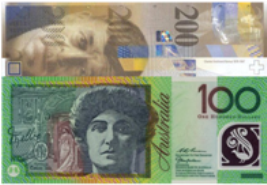AUDCHF
AUDCHF consists of two currencies, namely the Australian dollar and the Swiss franc.
This instrument has an order of magnitude lower liquidity than such popular instruments as pound/dollar and euro/dollar.
magnitude lower liquidity than such popular instruments as pound/dollar and euro/dollar.
The main disadvantage of working here is that almost all brokers place a large spread on it, which makes trading simply unprofitable for scalpers and traders who prefer to trade short positions.
For example, the InstaForex broker set a spread of 10 points, and as you understand, seeing a negative balance immediately after opening a position, and even a spread of 10 points carries a large psychological load.
Before we talk about forecasting the exchange rate for this instrument, let's look at each of the currencies separately.
Australia has good trade relations with Asian countries, so there is a clear relationship between the growth and decline of the country's trade turnover and the movement of the Australian exchange rate. It is believed that there is virtually no pressure on the exchange rate of the national currency from the Australian authorities.
The country is considered a resource-producing state, so the main indicators of sales, extracted resources, and weather conditions are the main driver of this currency.
The AUD exchange rate is directly affected by the main economic indicators, as well as the speeches of heads of state. Traders pay special attention to interest rates when working with this instrument. It is interest rate data that has the greatest influence on price movements.
Also, do not forget that Australia owns deposits of gold, which it actively mines. Therefore, many analysts often rely on the indicators of this country when making a forecast for gold. The Swiss franc is the national currency of Switzerland.
Probably, only small children do not know about Swiss banks and how all the rich people in the world like to store money there, although most likely even they know where they will store the millions they earn. Switzerland has the most stable economy in the world, which has remained stable for centuries and does not even know about such a problem as inflation. The only time in history when a devaluation of the CHF was recorded was the so-called Depression period in 1936, and then the world's major currencies depreciated by 30-40 percent.
Switzerland is a world-famous offshore zone where money from all over the world flows like a river. The main economic partners are European countries, so the CHF very often reacts to the instability of the European currency. Due to the fact that Switzerland has the strongest economy, the CHF movement is no longer influenced by the country’s economic indicators, but by political statements and the policy of the state’s Central Bank.
Since Switzerland is the most reliable refuge for investor money, during a period when the world is engulfed by waves of crises, many investors try to keep their funds in the currency of this state.
Therefore, anyone who has ever tracked the CHF exchange rate has noticed that during crises, the Swiss greatly strengthened its position and grew in price. An important feature of the AUDCHF currency pair is that it is sensitive to any fluctuations in the dollar.
Although, looking at the AUDCHF configuration, you will probably say what does the dollar have to do with it? In fact, the economies of these countries are very connected to the United States, and therefore react to dollar fluctuations in the same way. To predict further development of the AUDCHF price, I recommend paying attention to the main fundamental indicators for the dollar. For example, the dollar is sensitive to indicators of the discount rate, unemployment rate, jobs (reduction, opening), GDP and indicators by economic sector. Therefore, by tracking news on the dollar, you will always be aware of possible price developments for AUDCHF.

